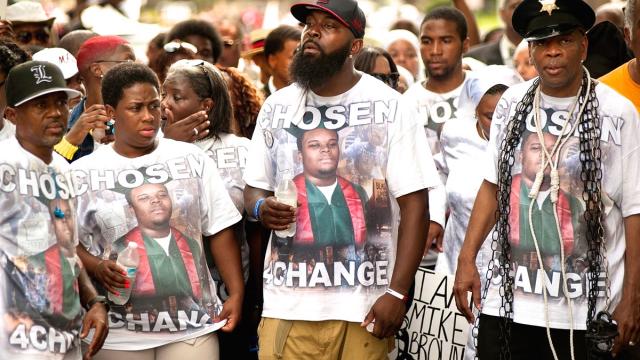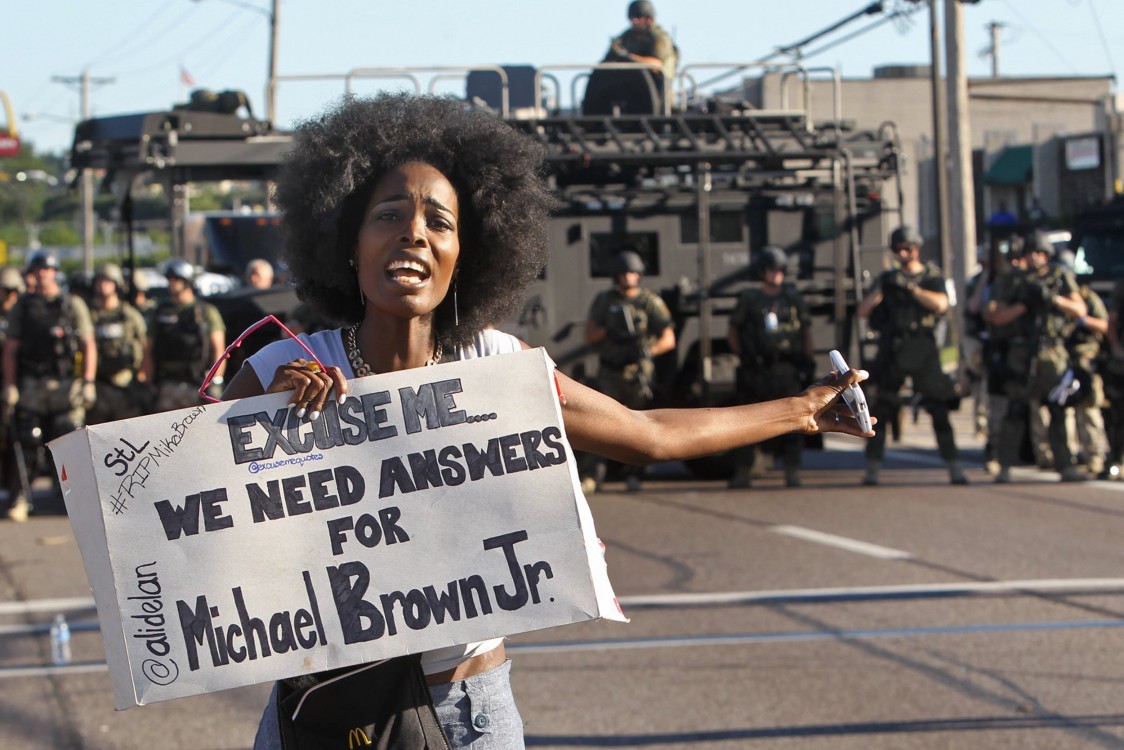
The birthplace of the new civil rights movement that has brought sound and fury to the streets of America fell silent on Sunday, as protesters reunited to mark the first anniversary of the death of Michael Brown in Ferguson, Missouri.
Hundreds of people gathered on the residential side street where Brown, an unarmed black 18-year-old, was shot dead by a white police officer last August, in a confrontation that caused months of civil unrest to ripple across the U.S. from the small suburb of St. Louis.
From 12:02 p.m., they hushed for four and a half minutes – one for each hour Brown was left lying uncovered on Canfield Drive in the midday heat after being shot, a situation which enraged his friends and family. On Sunday they stood at the spot where blood trickled from his body, since repaved and adorned with soft toys and candles, while supporters packed on to balconies overlooking the site.
“As we stand here, this is sacred ground,” said Yonasda Lonewolf, an activist and granddaughter of Louis Farrakhan, the leader of the Nation of Islam. “This was the epicentre of a movement, of Black Lives Matter. Our black lives matter. It has been a year and no justice has been made.”
Speaker after speaker lambasted the response to Brown’s death by authorities. A state grand jury declined last November to bring criminal charges against the officer, Darren Wilson. A parallel inquiry by the Obama Justice Department decided against prosecuting Wilson for violating Brown’s civil rights.
Brown’s parents are suing Wilson and the city, alleging a wrongful death. While some witnesses said Brown raised his arms as if to surrender – leading to the protest movement’s slogan, “hands up, don’t shoot” – others supported Wilson’s allegation that the 18-year-old turned and advanced on him aggressively after fleeing a struggle at his police car.
In his own brief remarks, Brown’s father Michael Sr on Sunday asked only that people stop asking him how he was feeling, which he described as “the dumbest question” a year after the loss of his eldest son.
“I just don’t get it,” he said. “How about, ‘How was your day?’ or ‘How is this moment?’”
Brown Sr. stood for the memorial service alongside relatives of other black men killed by police in high-profile incidents, such as Erica Garner, whose father Eric was killed by a choke-hold inflicted by a New York City officer last year while a bystander filmed on his mobile phone. The officer was also cleared of wrongdoing by a grand jury and is seeking to return to work. Brown’s mother, Lesley McSpadden, did not attend the public events.
“This year has just been so hard,” said Erica Garner. “No accountability, no justice. People are still killing us. It’s a crisis that’s going on.”
A Guardian investigation has found 25 unarmed black men killed by U.S. police so far in 2015. In all, more than 700 people have died, with African Americans more than twice as likely as white people to appear among those counted.
A towering presence with an intensely mournful stare, Brown Sr, 38, has not cut his beard since the day his son died, leading one US magazine to note he had taken on the appearance of “a figure from the Old Testament”. Speaking on Saturday, he urged protesters to intensify their efforts to reform the criminal justice system.
“I see things moving in a positive way, but I don’t see enough,” he said.
Authorities have come under pressure to overhaul policing after a string of controversial killings including Brown’s. The Black Lives Matter movement, kickstarted by the events in Ferguson, has in recent weeks made a sharp impact on the Democratic party’s 2016 presidential primary contest, pushing Hillary Clinton and senator Bernie Sanders to explicitly support reforms intended to rid law enforcement of institutional racism.
Last year, protesters who took to the streets of Ferguson to demonstrate against Brown’s death were met by waves of police in riot gear backed by military style vehicles. In nightly clashes, a mostly white force drawn from several local departments swept young African American crowds out of the city with teargas and rubber bullets.
The scenes repeated in Baltimore, Maryland, in April after Freddie Gray, a 25-year-old black man, died from a broken neck during a so-called “rough ride” in the back of a police van.
During a weekend of events to mark the anniversary, hundreds of people demonstrated peacefully at the scene of Brown’s shooting and outside the Ferguson police headquarters. Commanders allowed protesters to gather in the road and remained largely out of sight, preventing the escalating confrontations that led to dozens of arrests at past demonstrations.
Away from the protests, one man was shot on Saturday night on West Florissant Avenue, the site of most of last year’s clashes.
On Sunday the same sweltering humidity felt in the days after Brown’s death grew as speakers paid their tributes. But as the minutes of silence concluded and crowds prepared to line up behind his father for a quiet walk to a nearby church, clouds parted and the sun cut through.
3 WAYS TO SHOW YOUR SUPPORT
- Log in to post comments
















